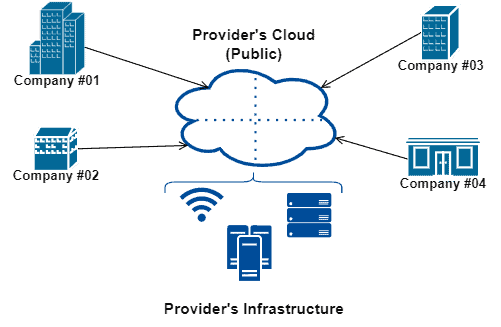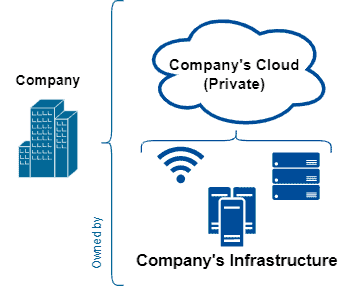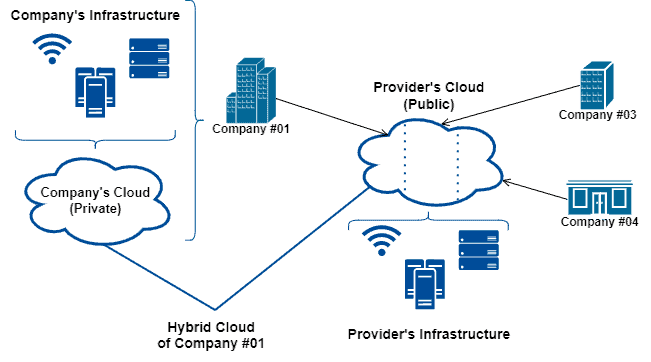1. 引言
随着网络技术的普及,通信方式发生了深刻变革,这也极大提升了计算资源的管理与调度效率。如今,我们不仅可以通过浏览器访问内容,还能运行应用、调用服务。
这些能力大多依托于云计算(Cloud Computing)范式实现。但需要注意的是,云计算并非单一模式,根据运营方式和访问权限的不同,我们可以将其分为三类:私有云(Private Cloud)、公有云(Public Cloud)和混合云(Hybrid Cloud)。
在本文中,我们将先了解云计算的基本概念,然后分别探讨私有云、公有云和混合云的核心特点,最后进行系统性对比,帮助你根据实际需求选择最适合的云架构。
2. 什么是云计算?
在互联网尚未普及的早期,企业和个人若需更多计算资源,往往需要不断升级硬件设备。这种做法虽然可行,但成本高昂,且部署周期长。
于是,云计算应运而生。简单来说,云计算就是通过网络将数据中心的计算资源虚拟化,并提供给多个用户使用。
这些资源可以根据负载自动扩展(包括向上、向下、向外、向内扩展),并通过复杂的管理机制进行调度。同时,云服务通常采用 X-as-a-Service 模式(如 IaaS、PaaS、SaaS),用户按需使用,按量付费,即所谓的“按需付费”(Pay-as-you-go)模式。
这种模式不仅提高了资源利用率,也大幅降低了企业的前期投入。
3. 公有云(Public Cloud)
✅ 什么是公有云?
公有云是由第三方提供商通过互联网提供的云服务。用户无需自行维护基础设施,只需定义所需的资源、服务和扩展策略,提供商即可按需部署环境。
✅ 优势
- 快速部署:无需物理设备和专业运维团队,开箱即用。
- 低成本维护:提供商负责底层基础设施,用户只需关注业务。
- 灵活计费:按实际使用量付费,成本可控。
❌ 劣势
- 安全性较低:由于多个用户共享资源,潜在安全风险更高。例如,某用户遭受攻击,可能影响整个云平台。
- 定制性差:用户对底层硬件和网络配置控制有限。
下图展示了公有云的典型结构:

4. 私有云(Private Cloud)
✅ 什么是私有云?
私有云由单一组织完全拥有和管理,不对外部用户开放。企业需自行部署并维护所有基础设施,包括服务器、存储、网络等。
✅ 优势
- 高度定制化:可根据企业需求定制硬件、网络和安全策略。
- 更强的安全性:数据不与其他用户共享,更易满足合规要求。
- 完全控制权:企业对资源分配、扩展策略等有完全决策权。
❌ 劣势
- 初期投入大:需购买服务器、存储设备等硬件。
- 运维成本高:需配备专业团队进行日常维护和升级。
- 扩展性受限:相比公有云,资源扩展速度和灵活性较低。
下图展示了私有云的典型架构:

5. 混合云(Hybrid Cloud)
✅ 什么是混合云?
混合云是私有云与公有云的结合体。企业保留私有云以确保数据安全和核心业务稳定性,同时借助公有云实现弹性扩展和快速部署。
例如,企业可将敏感数据和核心服务部署在私有云中,而将非敏感业务或突发流量需求部署在公有云上。
✅ 优势
- 安全与灵活兼得:敏感数据保留在私有云,其他业务部署在公有云。
- 弹性扩展:按需调用公有云资源,应对流量高峰。
- 政策驱动部署:可设定规则,自动将某些任务迁移至公有云。
❌ 劣势
- 管理复杂度高:需协调私有云与公有云的运维团队。
- 集成难度大:需确保两者之间的网络、数据、安全策略无缝对接。
下图展示了混合云的典型结构:

6. 系统性对比总结
| 特性 | 公有云 | 私有云 | 混合云 |
|---|---|---|---|
| 管理复杂度 | 低 | 中 | 高 |
| 定制能力 | 低 | 高 | 高 |
| 安全性 | 依赖提供商 | 可定制 | 可定制 + 依赖提供商 |
| 用户数量 | 多 | 单 | 私有部分为单用户,公有部分为多用户 |
📌 没有哪一种云是绝对最优的,选择应基于企业的实际需求、预算、安全要求和运维能力。
7. 总结
本文系统地介绍了云计算的三种主要类型:公有云、私有云和混合云。
- 公有云适合希望快速部署、控制成本、不需要深度定制的企业;
- 私有云适合对安全性和合规性有高要求、具备一定运维能力的企业;
- 混合云则是两者优势的结合,适合需要兼顾安全与灵活性的中大型企业。
📌 选择哪种云架构,最终取决于你的业务目标和资源能力。建议结合自身实际情况,进行多维度评估后再做决策。
希望这篇文章能为你在云架构选型上提供清晰的参考方向。